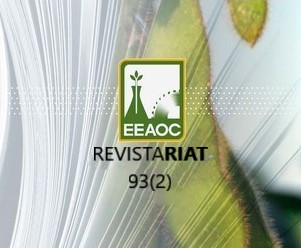Assessment of bioactivators in sugarcane, Tucumán, Argentina
Trabajo presentado en el XXV Congreso de la International Society of Sugar Cane Technologists (ISSCT), Sao Paulo, Brasil, 24 al 27 de Junio de 2013 y publicado aquí con el acuerdo de la Sociedad.
Palabras clave:
bioactivadores, estrés hídrico, bioactivator, water stressResumen
We evaluated the use of a foliar bioactivator at the beginning of the rainy season, as a strategy to accelerate sugarcane recovery after it had undergone the negative effects of water deficits at the onset of the crop cycle. Three trials were carried out in commercial fields planted with variety LCP 85-384 in the first and second ratoon crops, located in areas with different water stress levels and with soils with different organic matter content. Four treatments were evaluated: 1) a control; 2) bioactivator 2 L/ha (B); 3) conventional fertilisation at a rate of 115 kg of N/ha (CF) and 4) CF + B. At harvest, stalk population and stalk weight were measured and yield was estimated for each treatment. These assessments were complemented with sugarcane factory yield analyses. All the data were analysed with an ANOVA and a Fisher’s test (at 5 and 10% levels of statistical significance). All treatments had significant differences compared to the control regarding stalk population, but the greatest stalk population was obtained with the CF + B treatment (16% > control). All treatments had significantly greater stalk weight (P< 0.10) than the control, but stalk weights did not differ among fertiliser or bioactivator treatments. Weight increases measured in treatments with bioactivators (B and CF + B) amounted to 12%. All treatments had significantly greater cane yield when compared to the control treatment, with the greatest increases attained with the CF + B treatment (29.2% > control). The use of bioactivators influenced yield components in two different ways: when the sugarcane crop was fertilised with N, the bioactivator significantly increased stalk population, whereas in the case of crops without fertilisation, the effect was evident in both stalk population and weight.
RESUMEN
Evaluación de bioactivadores en caña de azúcar, Tucumán, Argentina
Se evaluó el empleo de bioactivadores foliares en el inicio del período de lluvias en Tucumán, R. Argentina, a fin de facilitar la recuperación del cultivo ante las deficiencias hídricas que sufre el cañaveral en la fases iniciales del ciclo. Se realizaron 3 ensayos en lotes comerciales de caña soca, variedad LCP 85-384, en áreas con diferencias en el régimen pluviométrico y en el contenido de materia orgánica. Se evaluaron 4 tratamientos: Control; Bioactivador 2 l/ha (B); Urea dosis convencional de 115 kg N/ha (CF); CF + B. En cosecha, se determinó la población de tallos y su peso unitario, y con estos datos se estimó el rendimiento cultural. Además se evaluó la calidad fabril. La información fue analizada con un ANOVA y el test de Fisher (al 5% y 10% de significación). Todos los tratamientos manifestaron diferencias significativas con el testigo al analizar la población de tallos, registrando las mayores diferencias el tratamiento CF + B (16%). En el peso por tallo, todos los tratamientos mostraron diferencias significativas respecto del testigo, pero sin diferencias entre ellos. Los incrementos alcanzados por los tratamientos con bioactivadores (B y CF+B) resultaron de un 12%. En el rendimiento cultural todos los tratamientos manifestaron diferencias significativas respecto del testigo, registrando los mayores incrementos el tratamiento CF + B (29,2%). El bioactivador influyó sobre los componentes del rendimiento de 2 maneras: cuando el cañaveral fue fertilizado con N, el efecto se manifestó en la población de tallos, mientras que en los cañaverales sin fertilizar, el efecto se presentó también en el peso por tallo.
Descargas
Citas
García, I., Llerena, E., Díaz, J.C. et al. (2001). Uso de bioestimulante natural en el cultivo de la caña de azúcar. EPICA. Villa Clara, Cuba. Centro azúcar 2/2001.http://www.biblioteca.idict.villaclara.cu/biblioteca/artículos/ciencia/art91
Peruvian Seaweed. Accessed 17 April 2012. http://www.pswsa.com/nuevosite/biomestimulantes.html
Descargas
Publicado
Cómo citar
Licencia
Derechos de autor 2016 Alonso et al.

Esta obra está bajo una licencia internacional Creative Commons Atribución-NoComercial-CompartirIgual 4.0.






